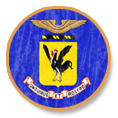From Japan To “Dogpatch” for the 18th Group

During “the darkest hours of early September, when it appeared as though the ‘last gasp’ of the North Korean forces might carry their drive around Taegu and south to the port of Pusan,” the 18th Fighter-Bomber Group “labored at peak efficiency, despite miserable flying weather and an untimely move from the comparative comforts of Japan to the newly-constructed airstrip in Korea designated, simply, K-9.”
On September 7th the entire 18th Fighter-Bomber Group moved to K-9 airstrip near Pusan. This move to “Dogpatch,” as the new base was immediately named, was the second such transfer for the 12th FBS, but it now placed the fighter-bombers, “within fifteen minutes flying time of the front lines and permitted ground-support operations, though limited, in even the foulest weather.” 2
Origin of “Dogpatch”

Heat waves shimmered upward from rain pools alongside the airstrip at K-9, S/Sgt William J. “Sandy” Colton, a public information specialist attached to the 18th Wing Staff later reported. Colonel Curtis Low, Captain George Bales, and Colton surveyed the “uninspiring Korean landscape” from their ankle-deep vantage point in the mud. “Lower Slobovia or Dogpatch couldn’t be worse than this,” commented Low, while his two companions nodded weary agreement. Thus, Dogpatch received its Cappian title, which was to eventually be picked up by the stateside press and become a familiar label of the 18th Fighter-Bomber Wing.
Following the relocation of the 18th to K-9, Colton began datelining his news dispatches with the descriptive title and before long the 18th became identified as the “Dogpatchers of Korea.” In fact the 18th became synonymous with Al Capp’s comic strip village to such an extent, Colton noted, “that celebrities of the Bob Hope, Marilyn Maxwell and Jolson stature were usually met with banners and signs proclaiming proudly that the 18th was truly an airborne version of the popular stateside cartoon strip.”

A letter dispatched through channels to Al Capp himself soon brought recognition from Li’l Abner’s creator, who followed through by designing a Mustang motif patch with Nancy 0. and Abner astride a death-dealing F-51. This same insignia was featured on television and aroused such interest that the Texstyle Corporation sent along as a present full-color cloth patches for the Dogpatchers of the Fifth Air Force.
By late 1951, Al Capp was an honorary member of the 18th and “would be amazed at the Dogpatch signs around the base,” Colton noted. “Everything from the new control tower to the mess hall menus proclaim that the 18th is proud of its humble beginning in Korea, but more important we had a sense of humor that war could not lessen but only served to inspire everybody to greater efforts. In other words we could always eke out a laugh no matter how rough it was. Regardless of the hardships it may have been ‘confoozin,’ but it was still ‘amoozin.’”
First Dogpatch Established at Pusan East (K-9) Air Base
The Pusan East (K-9) Air Base was adjacent to the Suyeong River in Haeundae District, Busan, South Korea. [It was redeveloped in the 1990s as Centum City, a commercial and residential area.]
The runway at K-9 was basically a 6,000-foot long “steel mat, which had not been completed.” There were “a handful of weather-beaten buildings to form the new base.” The “officers and airmen immediately pitched a ‘tent city’ and set up housekeeping without a break in operations against the enemy. The move was planned and executed to “allow the Mustangs to take off from Ashiya, make their strikes, then stage from K-2 airstrip at Taegu. At the end of the day they landed at their new home and were ready for normal operations by the following day.”

Gradually, “necessary supplies and equipment” arrived from Japan and the “primitive” living conditions were slowly improved. By the end of September, “most” of the tents had wooden floors and a “contract laundry” was available to personnel. A “belated shower arrangement” proved “immensely popular in spite of the cold weather.” Fresh food was “limited but greatly appreciated.” 3
Squadron operations, armament, maintenance and communications were moved to the opposite side of the strip at K-9. The sections were then consolidated and housed in seven squad tents per squadron, centrally located near the respective aircraft dispersal areas but on the opposite side of the strip from the housing area. “This arrangement proved to be very satisfactory from all points of view.” 4
On 7 September, the 18th Fighter Bomber Group headquarters and the 12th and 67th Squadrons were moved to K-9, ten miles east of Pusan, Colton noted. “This airstrip, like K-2, utilized the dirt and steel runway mats. All personnel were quartered in 12-man tents, and many of the Wing, Group, and squadron offices also used these tents.” 5

K-9 was important as an air evacuation and staging area. The wounded were brought from the Pusan Evacuation Hospital to K-9 by rail transportation, loaded on ambulance and 6×6 trucks, and then to C-119, C-54, C-46, and C-47 aircraft for flights to Haneda and Itazuke Air bases in Japan. This field was bordered on three sides by mountains a mile from the field, and on the other side by the sea. South Korean laborers were used in the Mess, on the Flight Line, and in installation of the Base. This was the largest field in South Korea and the only one capable of handling jet aircraft. Marine Corsairs (F4U), Navy Skyraiders, and RAAF F-51’s and C-47 aircraft of its 77th Squadron frequently operated from K-9. In addition, many high-ranking personnel of all nations passed through the field–Generals Walker and Stratemeyer flew from K-9 quite often.
© Copyright 2015 BelleAire Press, LLC
 Truckbusters
Truckbusters 